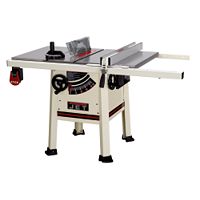 A friend of mine called me the other day "I need to buy an new table saw" he told me. "Why" I asked, "did you wear out your current one" (jokingly). "No, I gave it away to your brother-in-law". Now I have heard of lots of excuses to get a new table saw, but that was one of the better ones. "So I need to buy and new saw, what should I look for" he asked. Sure ... now I need to tell him everything he needs to know about buying a new table saw over the phone. Well ... here's what I told him ...
A friend of mine called me the other day "I need to buy an new table saw" he told me. "Why" I asked, "did you wear out your current one" (jokingly). "No, I gave it away to your brother-in-law". Now I have heard of lots of excuses to get a new table saw, but that was one of the better ones. "So I need to buy and new saw, what should I look for" he asked. Sure ... now I need to tell him everything he needs to know about buying a new table saw over the phone. Well ... here's what I told him ... My friendis, like many of us, a woodworker who does everything from fine woodworking to home improvement so he needs a decent saw, but as a hobbyist, it doesn't need to be a workhorse.
Here is what I explained to him. There are basically three kinds of table saws. The Bench top , which is the smallest table saw and somewhat portable, (if you can call a table saw portable). Bench tops are not sold with a stand (that's why they call them bench tops). The next size up is the Contractors saw. This is slightly bigger and usually sold with an open stand. The biggest of the table saws are called Cabinet saws because they usually are housed in some sort of a solid metal cabinet.
In terms of sawing power, the electric motors on the Bench top and Contractors saws are normally less powerful than those on the Cabinet saws. Some smaller saws will be "direct drive", this means that the blade attaches directly to the motor. Direct drive saws are fine, the disadvantage they have is that because of the composition of the motor (round) these saws cannot make as deep a saw cut as a table saw that is belt driven because the blade cannot be raised as high as a table saw that is belt driven.
Larger table saws also tent to have better fence systems. Ripping wood is one of the main purposes of a table saw so it is imperative to get a good rip blade, like the Freud Glue Line Rip, and even if you are just a hobbyist, a poor fence system can not only ruin your day, it can ruin piles of lumber for you, so make sure you are happy with the fence system you have when you purchase your saw.
Other issues like dust collection, power switches, blade height and angle controls and the size of blades the saw will take all come into consideration when looking for a new table saw. It is worth taking some extra time, and maybe some extra money to buy a table saw, they are without question the workhorse of most shops, you will never be sorry you bought a little bit better one.
Copyright Colin Knecht
Woodworkweb.com
